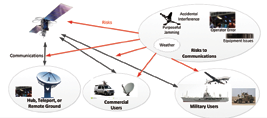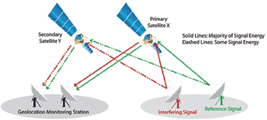Over the past several years, DoD and commercial protected communications technologies have been converging.

Steve Williams, left and Chris Badgett
Protected communications is a general term used to represent actions taken beyond the normal SATCOM transmission to reliably transmit and receive signals. Protected SATCOM goes beyond typical approaches related to increasing the overall link budget.
For DoD, Protected MILSATCOM is often implemented by an extremely high frequency service for strategic and tactical purposes. Strategically, protected MILSATCOM must provide low probability of interception/detection/exploitation (LPI/LPD/LPE), survivable, anti-scintillation and anti-jam communications, as well as command and control services in all operational environments: nuclear, contested and benign. Tactically, protected MILSATCOM must be able to provide anti-jam and LPI/LPD/LPE communications in both contested and benign operational environments. Commercially, protected communications attempts to minimize interference in the benign environment.
Although space based solutions exist, from the perspective of a ground system provider, protected communication solutions traditionally include increasing the resilience of the waveform or taking action to minimize interference. This is a large solution space; however, we will limit this article to actions taken in the RF or waveform domain.
What is driving the need for protected communications? There are several performance-impacting risks to SATCOM links.
The first risk to existing communications systems is from interference (intentional or unintentional) impacting user availability and thus revenue.
Second are risks to satellite communications as spectrum demand increases, which will put pressure on existing systems.
Third, technology has been slow to develop/embrace/embed new communications and protection techniques, leaving many systems vulnerable to interference.
These risks fall across a wide continuum of difficultly from a benign environment to a highly degraded one as in a nuclear scintillated condition.
Against these risks, various approaches can mitigate risks to user communications. The mitigation steps fall into the general categories of: a) sense, b) learn and adapt, c) protect and harden, and d) fight through.
To “Sense” a threat, users need to quickly know when something is wrong and when communications are being degraded or interrupted. In this regard, automatic signal monitoring is a desired approach and should go beyond simple spectrum analyzer mask analysis of bandwidth, center frequency and power level. In-depth and real-time threat sensing capabilities must include blind determination of interference modulation type, data rate, coding scheme, modulation error ratio (MER), error vector magnitude (EVM) and bit error rate (BER) to assist in attribution and eventual mitigation.
“Learn and Adapt” tools should provide data trending, analysis and the ability to understand what interference and risk is occurring in the environment over time. Effective data logging and monitoring should store historical, time-tagged measurement data for future trend analysis.
Such a repository is useful for predicting equipment failures, communications outages, and impending electronic attack preceded by detectable signal trends. Historical data can also be exploited to differentiate equipment problems from operator error, and between accidental or intentional interference.

When received or transmitted signals do not match parametric expectations, or are determined to be affected by interference, automatic alerts and data logging must take place. This assures that already time-crunched operators are not relegated to constant vigil or control over the monitoring system.
This type of signal sorting and logging can occur on a single SATCOM link, for a teleport, across an enterprise or even a battle group. Consolidating information at the enterprise level allows users and operators a Spectral Common Operational Picture (SCOP) of the threat environment.
To “Protect and Harden,” the next line of protection is to provide solutions that protect against the threats. A protection alternative is geolocating and identifying sources of interference due to equipment failure, operator error, intentional jamming, or unauthorized users.
 Figure 1. Protected communication has been converging between DoD and Commercial applications.
Figure 1. Protected communication has been converging between DoD and Commercial applications.Signal Geolocation systems pinpoint the Earth location of the disrupting signal. Once a physical location estimate of the transmitter is available, an assessment of friendly (accidental) or hostile (intentional) interference can proceed. Assisting in this determination, geolocation data can be combined with other location-specific intelligence.
The fastest and most accurate geolocation systems today receive SATCOM signals via two Earth-Satellite-Earth paths. They typically look at two signals during a geolocation—the interfering signal and a reference signal from a known location, as shown in Figure 3.
The last method for protection is to “Fight Through” which is to provide solutions that fight through threats using advanced signal processing. One example is to add more robustness at the waveform level to enhance LPI/LPD/LPE. Frequency Hopping and Direct Sequence Spread Spectrum (DSSS) are typical methods to help counter interference and jamming.
The Protected Tactical Waveform (PTW) is a new approach that uses frequency-hopping spread spectrum (FHSS) to provide greater anti-jamming capability and aims to combine features of the current MILSATCOM protected waveform and the commercial waveforms such as Digital Video Broadcast (DVB.) This hybrid strategy tries to obtain a balance between protection and affordability.
Test + Training Capabilities
As with any material solution, test and simulation is an important element of each of the four protection mitigation steps (sensing, learn and adapt, protect and harden, and fight through).
 Figure 2. Monitoring and Detection enables you to know when your RF Link is experiencing interference, whether accidental or deliberate.
Figure 2. Monitoring and Detection enables you to know when your RF Link is experiencing interference, whether accidental or deliberate.Channel Simulators, Transponder Simulators and Satellite Signal Emulators are extremely valuable during the development and test of link-protecting modems, receivers, transmitters and waveforms. These advanced instruments can generate nominal and worst-case SATCOM test signals within a controlled and secure lab environment. Engineers can then design and tune their firmware, software and hardware for unimpeded communications even under degraded and highly contested signal conditions.
In the laboratory, Channel Simulators and Transponder Simulators create physics-compliant signals indistinguishable from their real world counterparts. These signals include propagation effects modeling, interference injection, motion-related Doppler shift, atmospheric and multipath fading, path delay, and atmospheric noise profiles. Furthermore, these systems can simulate spacecraft equipment effects, duplicating amplitude and phase response and introducing linear and non-linear signal distortions.
High fidelity Satellite Signal Emulators accurately represent complex uplink and downlink signals, and are valuable tools for system developers, testers and trainers. These instruments fully emulate complex communications systems found on the emerging generation of channelized, multi-beamed satellites, such as the Wideband Global SATCOM (WGS) constellation.

Figure 3: Geolocation systems today use a two-path solution to find interfering signals.
By enabling deeper, repeatable, continuous training strategies these solutions allow operators to understand exactly how their equipment will perform under challenging signal conditions, giving them valuable experience to hasten recognition of signal issues, differentiate causes, and restore link performance and function.
Integrated Solutions
An integrated system combines the primary protected SATCOM waveform with augmentation of spectral monitoring and geolocation, and built-in training. An integrated solution is unique and aligns to future capability that use modems as sensors in a spectrally aware manner as depicted in Figure 4, below. This provides the best of both worlds for protection.
With a spectral aware modem, cognitive radio (CR) capabilities can be furthered perused. CR has applications in commercial Ka-band High Throughput Satellite (HTS). Cognitive approaches offer new ideas to increase spectrum utilization. Ongoing research looks at CR applications to service future high density fixed satellite services while trying to minimize interference to existing users1.
Protected Communication has a wide aperture of material solutions that leverage capabilities from both Defense and Commercial applications. SATCOM links are vital infrastructure elements in commercial, as well as military command and control (C2) and data transport applications. Due to their mission-critical nature, the function and performance of these links must be protected with great attention, constancy and attention to detail.

Figure 4. An Integrated Solution offers waveform protection and spectral monitoring.
Steve Williams is the Business Area Manager of Signals Instrumentation at RT Logic and may be reached at swilliams@rtlogic.com.
Chris Badgett is the Business Area Manager of Mission Data Processing at RT Logic and may be reached at cbadgett@rtlogic.com.
References
1Cognitive Spectrum Utilization in Ka-Band Multibeam Satellite Communications, IEEE Mar15
About the companies...
Assuring Satellite Performance…From the Ground Up
RT Logic, a Kratos Company, is the leading supplier of ground-based equipment for space/ground communications. Ninety percent of America’s space missions use RT Logic products during their test, launch, or on-orbit phase. RT Logic products test spacecraft communication subsystems at every major U.S. satellite factory, and support space-lift operations at the national launch ranges. These systems form the backbone of the majority of the nation’s operational satellite Telemetry, Tracking and Command Systems (TT&C) ground networks and downlink critical high rate remote sensing mission data from LEO, HEO, and GEO satellites.
Kratos’ RT Logic specializes in developing COTS and tailored products for monitoring, detecting, characterizing and mitigating RF interference and other challenges to protected communications. RT Logic’s line of test equipment also includes channel simulators, signal emulators, UAV, target and missile testers, as well as range test systems. These systems enable comprehensive test and training activities without actual flights of assets through real-time, hardware-in-the-loop emulation of propagation effects, rather than computer-based, off-line simulation.


